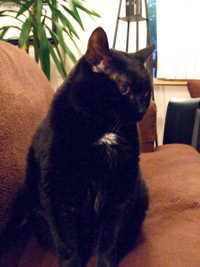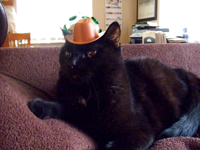We at the Moab BARKery have been writing about our own pet experiences to share with readers about our triumphs, mistakes and what it has been like to live with and learn from our own brood of animals. There are both cats and dogs in our house so we have a big selection of stories to write about, this is the final installment of the series talking about our cats. Most people have that one pet who they have shared their life with that really leaves a lasting impression, even after they are gone, for me that cat is The Puss.
 The Puss was a dominant force to be reckoned with for 14 years, she could be loving and sweet one moment and angry and aggressive the next. She HATED to be touched, was really mean to the other animals that she shared space with and would bite without warning. There were many things that contributed to the Puss being the demon cat she became, but the most significant factor was the fact that she was de-clawed. In addition to this she was a pet store kitten, had respiratory issues, was over-weight for most of her life and developed feline diabetes later in life. The Puss was a dominant force to be reckoned with for 14 years, she could be loving and sweet one moment and angry and aggressive the next. She HATED to be touched, was really mean to the other animals that she shared space with and would bite without warning. There were many things that contributed to the Puss being the demon cat she became, but the most significant factor was the fact that she was de-clawed. In addition to this she was a pet store kitten, had respiratory issues, was over-weight for most of her life and developed feline diabetes later in life.
Buying kittens that have been irresponsibly bred, handled, and sold more often supports cruelty and perpetuates production of cats with serious physical and mental problems. Pet stores get their “merchandise” – that is what kittens and puppies are to them – from commercial breeders, brokers, kitten mills and backyard “accidental” breeders. With all the wonderful cats and kittens available from shelters and rescue groups as well as responsible breeders, it’s hard to imagine that you’d want to support irresponsible breeding or selling of cats, but it is easy to be misled by people whose only goal is to make money. By adopting a pet from an animal shelter or rescue, you can not only find a wonderful pet, but help curb the problems in the pet-sales industry.
If you are considering de-clawing your cat please pay attention and understand what you are really doing to your cat. De-clawing is not like a manicure, it is serious surgery. Your cat’s claw is closely adhered to the bone, so close that in order to remove the claw the last bone of your cat’s toe has to be removed. De-clawing is actually an amputation of the last joint of your cat’s toes, a painful surgery with a painful recovery period. Remember during the time of recuperation from the surgery your cat will still have to use its feet to walk, jump, scratch in its litter box regardless of the pain it is experiencing.
 Amputating a cat’s claws drastically alters the conformation of their feet and also deprives them of their primary means of defense. There are humane ways to deal with scratching, teach your cat to use a scratch post, consider using Soft Paws®, vinyl coverings for their claws, trimming their nails on a regular basis or using a pheromone based product like Feliway®. Most medical professionals do not agree but de-clawing can and often changes the cat’s personality. After surgery the Puss kept re-injuring her surgical wounds and would traipse bloody paw prints all over the house, she was in extreme pain and this manifested itself in biting, growling and hissing, all behaviors that never left her. The Puss continued to favor one front paw for the rest of her life and would often hold the other up while sitting, she also developed arthritis at an earlier age than expected. Amputating a cat’s claws drastically alters the conformation of their feet and also deprives them of their primary means of defense. There are humane ways to deal with scratching, teach your cat to use a scratch post, consider using Soft Paws®, vinyl coverings for their claws, trimming their nails on a regular basis or using a pheromone based product like Feliway®. Most medical professionals do not agree but de-clawing can and often changes the cat’s personality. After surgery the Puss kept re-injuring her surgical wounds and would traipse bloody paw prints all over the house, she was in extreme pain and this manifested itself in biting, growling and hissing, all behaviors that never left her. The Puss continued to favor one front paw for the rest of her life and would often hold the other up while sitting, she also developed arthritis at an earlier age than expected.
By the time the Puss was four, she was overweight. A combination of poor quality food and over eating was the cause. With the weight gain came a respiratory issue, she would cough like she had a large hair ball but nothing would ever materialize. She was seen by multiple vets who could never diagnose her issue and would just suggest that we use Prednisolone, a corticosteroid that is designed to treat inflammatory and auto-immune diseases. The problem with this is that the very drug they were prescribing caused her appetite to increase and she gained more weight. The longer she was on the steroids the worse she got and the coughing really did not improve and in fact was the largest contributing factor to her developing diabetes. In hindsight we suspect that she may have been exposed to heart worm as a kitten, had environmental allergies or was born and raised in a suspect environment as a kitten.
Once the Puss was diagnosed with diabetes we decided that we would no longer continue to use the steroid and chose to control her health with diet. It was a radical change that she did not take to kindly at first. Her food intake was reduced significantly, whilst the quality of her food increased exponentially. Initially she was fed a grain-free kibble, cats are obligate carnivores and grain is not of any nutritional use to them. Grain-Free canned food was slowly integrated into her diet, which helped her reach her moisture requirement easier, which is really important for diabetic cats that have a voracious need to drink. An attempt to introduce her to a raw diet was met with a nasty response, she looked at the bowl and offended she tried to bury it like it was a turd. The perfect food for a cat is a mouse; the only commercial cat food that mimics this is a pre-prepared raw diet like Stella and Chewy’s or Bravo.
Controlling the Puss’s diabetes with insulin was never an option; she was not the type of cat you could give a daily shot to. Insulin regulates blood sugar but so does a controlled grain free diet, both are as important to a diabetic cat’s survival. The Puss lived four years beyond her diagnosis with diabetes, without the use of insulin and if she was fed a quality diet from the beginning there is much less of chance that she would have developed diabetes.
The Puss passed away at the age of 14 in August of last year, what actually caused her death was kidney failure. She went five days without food and the last couple without water. To see such an intimidating force in such a weakened and helpless state was very difficult to say the least. Living with her was like riding the emotional roller-coaster, some times she was so sweet but for the most part she was just an angry cat. If I could have a do over she would not have been de-clawed and she would have been fed a better food from day one. It is never too late to help improve your cat’s health, so start now!
|